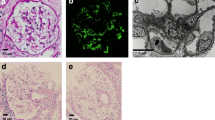Abstract
C1q nephropathy (C1qNP) is a controversial and uncommon form of glomerulonephritis, characterized by mesangial immunoglobulin and complement deposits, predominantly C1q, with no evidence of systemic lupus erythematosus. Clinically, it may present as nephrotic syndrome and non-nephrotic proteinuria per se or associated with microhematuria, hypertension, or renal insufficiency. We describe two sisters with C1qNP, who presented with steroid-resistant nephrotic syndrome. Both sisters presented before the age of 2 years, and they showed a poor response to other immunosuppressive therapy. Both girls had normal serum complement levels, negative antinuclear antibodies (ANAs) and negative hepatitis B antigen. Renal biopsy in both patients showed histological features of mesangioproliferative glomerulonephritis, with diffuse “full-house” positive immunofluorescence reaction in the mesangial area. The immunofluorescence reaction for C1q was most intense and co-dominant with IgG in both patients. Correspondingly, electron microscopy demonstrated dense deposits mainly in the mesangial areas too. We report on two young sisters with the characteristic features of C1qNP presented in early childhood. To the best of our knowledge, this is the first report of C1qNP in siblings.



Similar content being viewed by others
References
Jennette JC, Hipp CG (1985) C1q nephropathy: a distinct pathologic entity usually causing nephrotic syndrome. Am J Kidney Dis 6:103–110
Lau KK, Gaber LW, Delos Santos NM, Wyatt RJ (2005) C1q nephropathy: features at presentation and outcome. Pediatr Nephrol 20:744–749
Kersnik Levart T, Kenda RB, Avgustin Cavić M, Ferluga D, Hvala A, Vizjak A (2005) C1Q nephropathy in children. Pediatr Nephrol 20:1756–1761
Iskandar SS, Browning MC, Lorentz WB (1991) C1q nephropathy: a pediatric clinicopathologic study. Am J Kidney Dis 18:459–465
Sharman A, Furness P, Feehally J (2004) Distinguishing C1q nephropathy from lupus nephritis. Nephrol Dial Transplant 19:1420–1426
Jennette JC, Hipp CG (1985) Immunohistopathologic evaluation of C1q in 800 renal biopsy specimens. Am J Clin Pathol 83:415–420
Jones E, Magil A (1982) Nonsystemic mesangiopathic glomerulonephritis with “full house” immunofluorescence. Pathological and clinical observation in five patients. Am J Clin Pathol 78:29–34
Niaudet P, Gagnadoux MF, Broyer M (1998) Treatment of childhood steroid-resistant idiopathic nephrotic syndrome. Adv Nephrol Necker Hosp 28:43–61
Alshaya HO, Al-Maghrabi JA, Kari JA (2003) Intravenous pulse cyclophosphamide—is it effective in children with steroid-resistant nephrotic syndrome? Pediatr Nephrol 18:1143–1146
Srivastava T, Chadha V, Taboada EM, Alon US (2000) C1q nephropathy presenting as rapidly progressive crescentic glomerulonephritis. Pediatr Nephrol 14:976–979
Fukuma Y, Hisano S, Segawa Y, Niimi K, Tsuru N, Kaku Y, Hatae K, Kiyoshi Y, Mitsudome A, Iwasaki H (2006) Clinicopathologic correlation of C1q nephropathy in children. Am J Kidney Dis 47:412–418
Markowitz GS, Schwimmer JA, Stokes MB, Nasr S, Seigle RL, Valeri AM, D’Agati VD (2003) C1q nephropathy: a variant of focal segmental glomerulosclerosis. Kidney Int 64:1232–1240
Nishida M, Kawakatsu H, Okumura Y, Hamaoka K (2005) C1q nephropathy with asymptomatic urine abnormalities. Pediatr Nephrol 20:1669–1670
Kuwano M, Ito Y, Amamoto Y, Aida K (1993) A case of congenital nephrotic syndrome associated with positive C1q immunofluorescence. Pediatr Nephrol 7:452–454
Sardani Y, Qin K, Haas M, Aronson AJ, Rosenfield RL (2003) Bartter syndrome complicated by immune complex nephropathy. Case report and literature review. Pediatr Nephrol 18:913–918
Hanevold C, Mian A, Dalton R (2006) C1q nephropathy in association with Gitelman syndrome: a case report. Pediatr Nephrol 21:1904–1908
Roberti I, Sachdev S, Aronsky A, Kim DU (2006) C1q nephropathy in a child with a chromosome 13 deletion. Pediatr Nephrol 21:737–739
Ekim M, Ikinciogullari A, Berberoglu M, Tulunay O, Sencer H, Ozkaya N, Reisli I, Tumer N (2002) C1q nephropathy: a case with severe atopic dermatitis. Pediatr Nephrol 17:547–549
Skok J, Solomon E, Reid KB, Thompson RA (1981) Distinct genes for fibroblast and serum C1q. Nature 292:549–551
Thompson RA, Haeney M, Reid KB, Davies JG, White RH, Cameron AH (1980) A genetic defect of the C1q subcomponent of complement associated with childhood (immune complex) nephritis. N Engl J Med 303:22–24
Miura-Shimura Y, Nakamura K, Ohtsuji M, Tomita H, Jiang Y, Abe M, Zhang D, Hamano Y, Tsuda H, Hashimoto H, Nishimura H, Taki S, Shirai T, Hirose S (2002) C1q regulatory region polymorphism down-regulating murine c1q protein levels with linkage to lupus nephritis. J Immunol 169:1334–1339
Hannema AJ, Kluin-Nelemans JC, Hack CE, Eerenberg-Belmer AJ, Mallee C, van Helden HP (1984) SLE like syndrome and functional deficiency of C1q in members of a large family. Clin Exp Immunol 55:106–114
Johnson WG (1980) Metabolic interference and the + − heterozygote. a hypothetical form of simple inheritance which is neither dominant nor recessive. Am J Hum Genet 32:374–386
Rollnick B, Day D, Tissot R, Kaye C (1981) A pedigree possible evidence for the metabolic interference hypothesis. Am J Hum Genet 33:823–826
Author information
Authors and Affiliations
Corresponding author
Rights and permissions
About this article
Cite this article
Kari, J.A., Jalalah, S.M. C1q nephropathy in two young sisters. Pediatr Nephrol 23, 487–490 (2008). https://doi.org/10.1007/s00467-007-0644-6
Received:
Revised:
Accepted:
Published:
Issue Date:
DOI: https://doi.org/10.1007/s00467-007-0644-6




